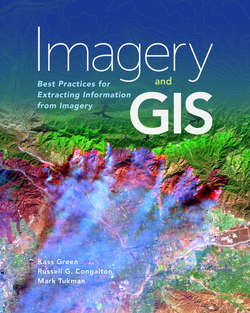Читать книгу Imagery and GIS - Kass Green - Страница 90
ОглавлениеChapter 5
Working with Imagery
Introduction
Chapter 3 presented a primer on imagery fundamentals, and chapter 4 provided instruction on choosing imagery appropriate for a given project. This chapter provides an overview of the fundamentals of working with the chosen imagery. The chapter begins by discussing the issue of scale in imagery and then covers a number of imagery processing and visualization topics including commonly used image storage and formats (pixel storage, image statistics, image compression, NoData, and image pyramids), image display fundamentals (histograms, image stretches), image enhancement and filtering, and image mosaics. The chapter concludes with a section on accessing imagery.
Image Scale
Using digital imagery and computers, it is easy to zoom in and out of an image, changing the scale of the display. Scale is the ratio of the length between two points on a paper or digital map to the actual distance between the same two points on the ground. It is expressed using a colon to differentiate between the distance of one unit on an image or map to the corresponding distance on the ground. For example, 1:15,840 is a scale commonly used in forestry applications where one inch on the image is equivalent to 15,840 inches (one-quarter mile) on the ground. This scale could also be represented with the units as 1 inch:0.25 miles.
The concepts of scale and spatial resolution are intertwined. Large-scale imagery has higher spatial resolution than small-scale imagery and, as a result, the terms “large” and “small” are a little counterintuitive. The term “large scale” refers to ratios with small denominators (e.g., 1:600) and images with high spatial resolution. The term “small scale” refers to ratios with a large denominator (e.g.1:60,000) and a corresponding lower spatial resolution.
